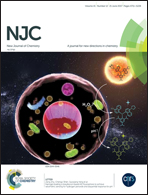Enhanced oxidation resistance and electrical conductivity copper nanowires–graphene hybrid films for flexible strain sensors†
Abstract
Copper nanowires (CuNWs) are extremely prone to oxidation, which greatly limits their practical applications, even though they are inexpensive, abundant and have high electrical conductivity. Herein, a facile and novel method is developed to alleviate the oxidation of CuNWs by embedding CuNWs into water-dispersible modified graphene (WGP) sheets to form a uniform hybrid conductive film using a simple vacuum filtration process. The CuNWs and WGP films possess electrical conductivity of 3.19 × 103 S m−1 and 5.6 × 103 S m−1, respectively. With the addition of WGP to form a CuNWs–WGP hybrid film, the electrical conductivity of the CuNWs is further improved to 3.02 × 104 S m−1 due to the synergistic effects of the CuNWs and WGP. The CuNWs–WGP hybrid films show excellent antioxidative stability even after exposure in air for 8 weeks without any obvious oxidation. Then, using this conductive hybrid film, a sandwich structured PDMS/CuNWs–WGP/PDMS flexible strain sensor was fabricated. The strain sensor exhibits good flexibility and stretchability with only less than 15% loss of electrical conductivity over 450 times mechanical bending, and was successfully used to monitor human motion, such as finger bending, swallowing and voice recognition.



 Please wait while we load your content...
Please wait while we load your content...